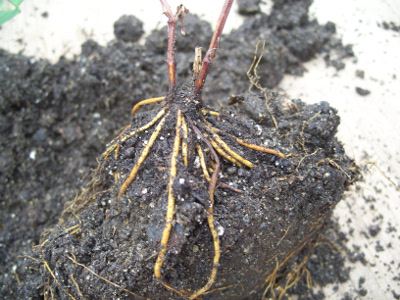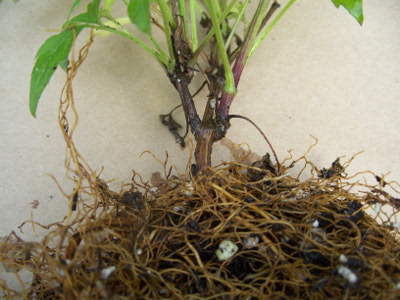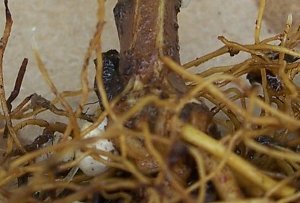Is My Clematis Dead?
Figuring Out If There's
Life In The Old Girl

One of the most common laments we hear at Hummingbird Farm is, "I think my clematis is dead!" And our most common reply is, "Are you really sure?" Clematis, unlike many plants, can "disappear" for many reasons, but that doesn't always mean they are gone forever.
Sometimes, in transporting a new clematis home and transplanting it into the garden, tender stems are cracked or broken, often without the gardener's knowledge. Sometimes, clematis are reluctant to "wake up: in the spring. Sometimes weather conditions are the culprit, other times it is insect or "critter" damage or disease. None of these are necessarily fatal!
But, But, But:
No Leaves! No Stems!
What's Alive??
If you have followed our Planting
Instructions, you know that
It's All About the Roots!
If your clematis has a strong root system, it will very often reappear like the Phoenix, given time, patience and careful watering. Not content to wait and wonder? With care, you can check the root system to see if it shows promise of recovery.
But Wait! Put that shovel away! Checking the root system must be done carefully by hand, so you don't damage it. Please be really gentle - use only your fingers to poke around at the roots!

This is what a typical clematis root system should look like, close to the surface of the ground. Note how heavy roots radiate out from the center. This is known as the "crown". As long as the crown is there and the roots are still pliable and orange in color, the roots are healthy.

Of course, not all clematis root systems are "typical"! Clematis virginiana has a more fibrous root system, consisting of about a bazillion fine roots. This is typical of a number of species clematis.

This close-up of virginiana gives a better look at how even those bazillion little roots still radiate out from the crown. And, no, you aren't seeing bug eggs - those white things are pieces of perlite, which is part of the potting mix.
I found the crown. Now what?
Wait and water. It won't take much water, but don't let the area dry out for an extended period of time. Speak sweetly to that empty space on occasion - and try to keep the cat from using the area as a litter box. Wait - your cat doesn't try to use every bit of bare ground for their own nefarious purposes? What's your secret??
I can't find a crown. Is my clematis dead yet?
Not necessarily. In Step 5 of the Planting Instructions, it says, "Place the clematis in the hole, 2 to 3 inches deeper than it was in its pot." If you did this when planting your clematis, there very well may be roots deeper down in the soil, which may enable the plant to recover.
Do NOT try to dig down to lower roots!
The chances of damaging roots are greater the further down you dig.
At this point you have two choices:
1. Wait and Water. Your clematis may yet "arise from the ashes", so don't plant anything else in the area, keep that spot watered (it won't need a lot when there's no top growth) and wait patiently. How long should you wait? That's up to you. Many, many clematis disappear for a year only to reappear the next spring. And we have customers who have had clematis reappear after four or five years. Our advice: wait a year and longer if you can stand it!
2. Shovel Prune. If there is no crown present at or near ground level and you don't want to wait a year or more to see if your clematis resurrects, by all means go ahead and remove it. We won't call the Plant Police on you!
